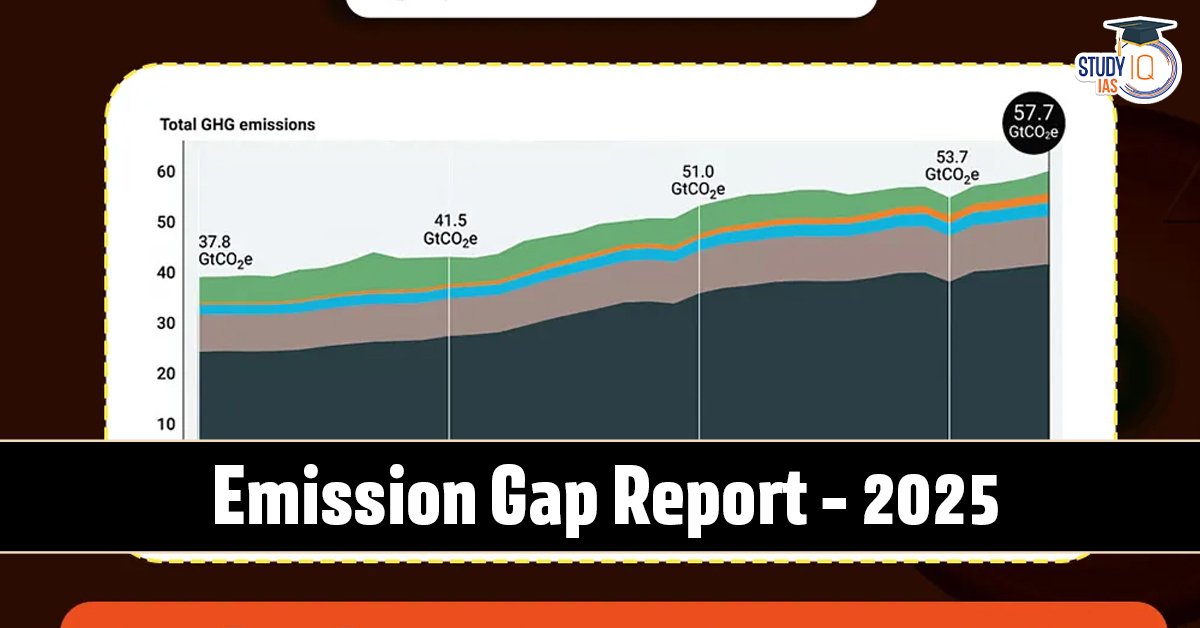Table of Contents
The Emissions Gap Report 2025, titled “Off Target”, has been released by the United Nations Environment Programme (UNEP). The sixteenth edition of this annual report warns that global efforts to curb greenhouse gas (GHG) emissions remain insufficient to meet the temperature targets of the Paris Agreement.
Despite new pledges from nations, global warming is still projected to rise by 2.3°C–2.5°C this century — far above the 1.5°C goal aimed at preventing catastrophic climate impacts.
What is the Emissions Gap Report?
The Emissions Gap Report (EGR) is an annual flagship publication by UNEP that tracks global progress in reducing GHG emissions. It measures the difference (“emissions gap”) between the emissions levels expected under current national pledges and the levels required to limit global warming to below 2°C or preferably 1.5°C above pre-industrial levels.
Key Details:
-
Published by: UNEP
-
Co-produced by: UNEP Copenhagen Climate Centre (UNEP-CCC)
-
Launched: Annually before the UN Climate Change Conference (COP)
-
Objective: To assess whether the world is on track to meet Paris Agreement goals
Emissions Gap Report 2025: Latest Findings
According to the UNEP Emissions Gap Report 2025, updated Nationally Determined Contributions (NDCs) have made only marginal progress in reducing global warming projections.
| Parameter | 2024 Report | 2025 Report | Trend |
|---|---|---|---|
| Projected global temperature rise (with full NDCs) | 2.6–2.8°C | 2.3–2.5°C | Slight improvement |
| Projected rise under current policies | 3.1°C | 2.8°C | Minor decline |
| Global GHG emissions (2024) | 56.4 GtCO₂e | 57.7 GtCO₂e | ↑ 2.3% increase |
| Countries submitting new 2035 NDCs | 46 | 60 Parties (63% of global emissions) | Moderate progress |
| Required reduction for 2°C target (by 2035) | — | 35% below 2019 levels | — |
| Required reduction for 1.5°C target (by 2035) | — | 55% below 2019 levels | — |
Key Highlights of the Emissions Gap Report 2025
-
Marginal Progress in Climate Pledges:
The new climate commitments under the Paris Agreement have barely moved the needle, achieving only a small reduction in projected temperature rise. -
Global Warming Projections:
-
With current pledges: 2.3–2.5°C rise by 2100.
-
With existing policies: 2.8°C rise by 2100.
UNEP warns that overshooting 1.5°C is now unavoidable within the next decade.
-
-
Rising Emissions:
Global greenhouse gas emissions increased by 2.3% in 2024, reaching 57.7 gigatonnes of CO₂ equivalent (GtCO₂e) — the highest ever recorded. -
Insufficient NDC Coverage:
Only 60 countries (representing 63% of global emissions) have submitted new 2035 climate pledges, showing slow progress toward global cooperation. -
Steep Reduction Required:
To stay within safe temperature limits:-
Emissions must drop 35% by 2035 for the 2°C pathway.
-
Emissions must drop 55% by 2035 for the 1.5°C pathway.
-
-
Technological Readiness:
The report notes that low-carbon technologies such as solar and wind power are cost-effective and scalable, but require rapid deployment. -
Geopolitical Challenges:
Ongoing geopolitical tensions, inadequate climate finance, and fossil fuel reliance continue to slow global climate action.
Climate Finance and Global Inequality
A major theme of the Emissions Gap Report 2025 is the urgent need for financial transformation. UNEP highlights that developing countries cannot transition to clean energy without substantial climate finance and debt reform.
It calls for:
-
Reforming international financial institutions
-
Mobilizing trillions in green investments
-
Increasing grants and concessional finance for low-income nations
Without such support, the emissions gap will continue to widen, especially in vulnerable regions like South Asia and Sub-Saharan Africa.
Positive Developments
Despite slow policy momentum, the report identifies encouraging trends:
-
Renewable energy costs continue to fall globally.
-
Electric vehicle adoption is increasing rapidly.
-
Corporate and sub-national actions (cities, states, industries) are filling some policy gaps.
-
Temperature projections have dropped from 3–3.5°C (2015) to ~2.5°C (2025) since the adoption of the Paris Agreement.
UNEP’s Warning
The report’s core message is clear:
“Every fraction of a degree avoided means fewer losses, lower costs, and less dependence on uncertain carbon dioxide removal technologies.”
UNEP urges immediate action to:
-
Accelerate renewable transitions,
-
Strengthen 2035 NDCs,
-
Phase out coal and oil dependence, and
-
Build resilience through adaptation policies.
India’s Position
-
India aims for Net Zero by 2070 and has significantly increased renewable energy capacity.
-
The country’s current NDC includes:
-
50% energy from renewables by 2030,
-
45% reduction in emission intensity of GDP, and
-
2.5–3 billion tonnes CO₂ sink through forests.
-
-
However, UNEP emphasizes that developing nations like India need financial and technological support to stay on low-carbon pathways.
Way Forward
-
Update and strengthen NDCs for 2035.
-
Enhance international climate finance to support developing economies.
-
Phase out fossil fuel subsidies and accelerate renewable deployment.
-
Promote just transition policies for workers and communities.
-
Enhance cooperation under COP30 and beyond to align global policies.
Conclusion
The Emissions Gap Report 2025 sends a stark reminder: the world is “off target” to meet its climate goals.
While technology and knowledge exist, political will and global cooperation remain the missing elements.
The next five years (2025–2030) will determine whether humanity can still limit catastrophic climate change or face irreversible environmental consequences.


 Industrial Parks in India: Driving Manuf...
Industrial Parks in India: Driving Manuf...
 National Maritime Heritage Complex (NMHC...
National Maritime Heritage Complex (NMHC...
 Reforming Fertiliser Subsidy in India: N...
Reforming Fertiliser Subsidy in India: N...

























